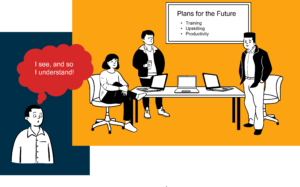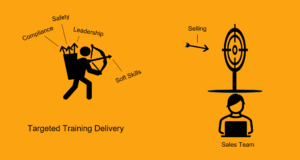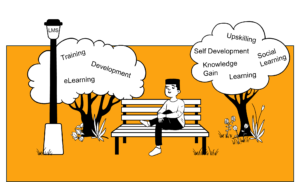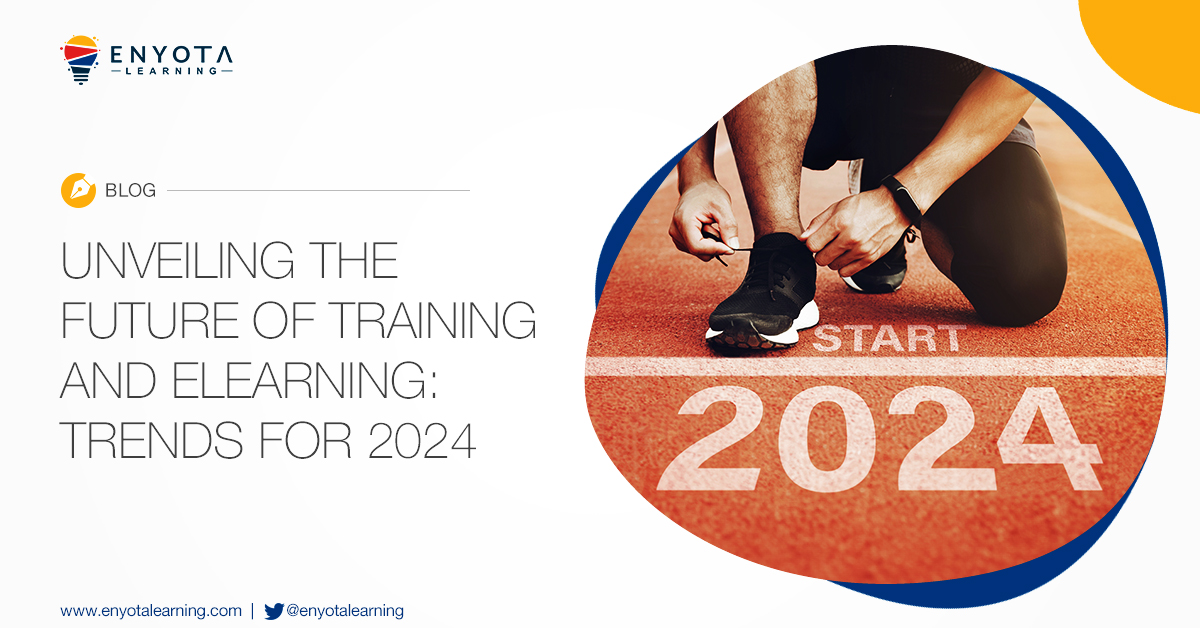Employee enablement is a crucial concept that every company must understand and consider. It involves empowering your existing workforce by providing them with the necessary skills and opportunities to better support your company’s needs. Enabling employees not only enhances employee performance, but also gives them a sense of purpose, making them more engaged with the business.
Employee growth through enablement is also a viable solution to plug the talent leak in companies where the failure to retain talent is eating into the bottom line. By upskilling your workforce, you enable employees to perform better and shoulder additional responsibilities, which ultimately benefits your company, allowing your business to not depend too much on an unpredictable talent market to hire new talent.
Every workplace can benefit from employee enablement, regardless of its current positioning. It is a cost-effective way to improve employee engagement, retention, and overall employee performance. Therefore, employee enablement should be a priority for every company to investigate and implement to suit their specific talent nurturing needs.
Also, employee enablement can be looked at as ‘your business valuing its employees.’ After all, if a business is ready to invest in building its workforce’s talent, then doesn’t that mean they value the people? By valuing your employees enough to contribute to their development, your business makes them feel important and appreciated. This is essential for employee retention and attracting new talent in a volatile job market. Monetary remuneration alone is no longer enough to attract top talent; employees now want a company that invests in their development.
In summary, employee enablement is an underappreciated concept that has the potential for high returns. By investing in your employees’ growth and providing them with the necessary tools and opportunities, you can create a positive work environment that benefits both your company and your employees.
What Truly is Employee Enablement?
Employee enablement is a powerful tool for any company looking to enhance its workforce. It involves actively assisting your employees in learning new skills and improving their abilities to perform their roles effectively. By doing so, you enable employees to realize and achieve their self-development goals, which in turn allows them to contribute to the growth of your company.
The benefits of employee enablement go beyond just employee satisfaction. By empowering your workforce with the skills they need to succeed, you can create a culture of innovation and creativity, leading to new ideas and strategies that can drive your company forward.
Overall, employee enablement is a win-win situation for both the employer and the employee. By investing in your workforce, you create a more engaged and productive team, which ultimately benefits your company’s bottom line. So, if you want to stay ahead of the competition, make sure you prioritize employee enablement as part of your company’s growth strategy.

Employee enablement is essential for ensuring that employees are performing at their best and aligned with the company’s goals and vision. By providing employees with the support they need to grow and develop their skills, they are better equipped to deliver top-quality performance.
For example, enabled employees are more likely to deliver exceptional customer service experiences, as they are motivated and engaged in their work. When employees feel valued and invested in, they are more likely to go above and beyond for customers, leading to increased customer satisfaction and loyalty.
By prioritizing employee enablement, companies can create a positive work culture that fosters growth and development, leading to a more productive and engaged workforce. This ultimately benefits the company’s bottom line, as employees are better equipped to perform their jobs and provide better customer service.
Here are 5 Key Strategies for Employee Enablement
- Maintain a culture of transparency
- Build a workspace where you listen to employees
- Provide many avenues for immediate learning
- Focus on targeted learning and development initiatives
- Nurture an environment that supports enablement
Maintain a Culture of Transparency
In order to enable employees to perform their best, it is crucial to provide transparency. This means ensuring that employees understand the purpose of their work and how it contributes to the company’s overall goals without anything being hidden from them.
By providing a clear context on everything central to your employees’ performance and growth, employees are better equipped to deliver optimal results, as transparency helps employees see the bigger picture and understand ‘why they do what they do each day.’ By prioritizing transparency at the workplace, companies can empower their employees to perform their best.
Types of Training that Contribute to Transparency:
- Onboarding which includes vision, mission, and company policy training
- Job role outlining which explains in detail the minutes of a job role
- Addressing company changes which helps employees learn about changes in the critical workings of the organization

Helping employees understand the reason behind corporate initiatives, clearly conveying organization goals, sharing performance data to keep them objective oriented, maintaining a clear, proactive, and effective feedback mechanism, all collectively contribute to creating a culture of transparency within an organization.
Build a Workspace Where You Listen to Employees
Creating a positive work environment where employee voices are heard is essential for effective employee enablement. This is because employees almost always try and communicate their needs to the employers in most cases. Listening to your employees is quick and effective method to determine ‘what employees need to perform better,’ since it comes from their mouth directly.
To identify the needs that empower employees to grow and perform their jobs better, employers must ‘prioritize listening to their employees.’ By actively considering the issues that employees voice – both overtly and subtly – employers can identify the enablers that allow employees to excel and the disablers that are holding employee back. Through this process, companies can foster an environment that supports employee growth and development.
How to Listen to Your Employees:
- Collect feedbacks via surveys
- Organize regular discussion sessions
- Train your employees to voice their opinions better

After listening to employees, it’s important for companies to take action and address their needs. By demonstrating commitment to meeting employee needs, companies actively promote a culture of engagement and strengthen the relationship between employees and the organization.
So provide multiple platforms for employees to voice their needs and showcase their work, and also take tangible actions to address employee concerns. By actively listening and responding to employee feedback, companies can empower their employees, build trust, and create a positive and productive workplace culture.
Provide Multiple Avenues for Immediate Learning
In fast-paced work environments, employees require access to growth opportunities both within the office and while on the go. In today’s tech-dependent world, employees demand greater flexibility to access training and development resources from anywhere, at any time. This is particularly important for distributed and mobile workforces, who may operate from different locations around the world.
To meet these demands, companies must provide multiple avenues for immediate learning and development that are not dependent on the availability of peers and colleagues. This includes providing access to critical ‘growth nurturing opportunities’ like training on mobile devices and/or allowing employees to access training and development resources with just a click of a button, anytime and anywhere.
Best ways to Provide Accessible Learning:
- Invest in mobile learning
- Invest in a modern LMS
- Build training in microlearning formats

To empower employees and drive enablement, companies must prioritize their training mobility strategies and provide employees with access to critical information and learning resources whenever and wherever employees need them.
This includes leveraging the power of mobile devices to enable immediate learning, whether it’s for business-critical information like information needed during a customer presentation or professional development opportunities like building skills to get a promotion. By making information and resources easily accessible on-the-go, companies can create a more agile and responsive workforce, and support employee growth and development.
Focus on Targeted Learning and Development Initiatives
Learning and development initiatives are a key indicator of how forward-thinking an organization is, particularly when it comes to enabling employees.
To nurture a workforce of empowered employees, companies must prioritize targeted and hyper-personalized learning initiatives that are tailored to individual needs and preferences.
This requires a deep understanding of employees’ immediate and future needs and a commitment to enabling continuous learning through adaptive and engaging experiences. By curating personalized training and development opportunities, companies can demonstrate their commitment to employee growth and development and foster a culture of continuous learning.

To effectively target and personalize learning and development initiatives for employees, companies should focus on several key areas. This includes optimizing knowledge dissemination by providing training materials in small, bite-sized pieces to enhance consumption and retention. Additionally, companies should use the right metrics to measure training success and adjust future training content based on the current assessments.
Businesses should also proactively provide specialized help and support to employees as needed. By prioritizing these areas during the targeting phase, companies can improve the effectiveness and impact of their learning and development programs, leading to a more empowered and engaged workforce.
Nurture an Environment that Supports Enablement
Modern organizations seek to hire employees who are capable of performing from their first day on the job. Although this seems like an ideal scenario, it is one that is only achievable through effective learning and development initiatives that provide employees with access to information regardless of their location from the very first day.
Collaboration is key to succeeding in the knowledge economy, and proactive learning processes can help overcome barriers to performance and learning. By providing an environment where employees can succeed via building themselves, companies can position their employees for success and benefit from their contributions.

To create an enabling environment, organizations must ask the right questions that go beyond simply understanding employee motivation. They must also consider the external factors that positively or negatively affect an employee’s ability to learn and develop. Because beyond an employee’s motivation to learn, lay other factors that affect an employee’s ability to learn and grow.
Also, training and development initiatives are not one-time events, but an ongoing process that must adapt to address the evolving goals and objectives of the organization.
And finally, by providing continuous learning opportunities, companies can ensure that employees have the necessary skills to contribute effectively to their job roles.
Also do read
- Why Employee Enablement is More Important than Employee Engagement
- Download Whitepaper – Employee Enablement Best Practices
Reach out to us at contact@enyotalearning.com and find out how we at eNyota help you enable your workforce with eLearning courses curated to meet your ambitious workforces’ needs. Or Sign Up Here and we’ll get back to you. We are also licensing our multiple award winning LMS – Abara, contact us below to know more about its pricing and more.




